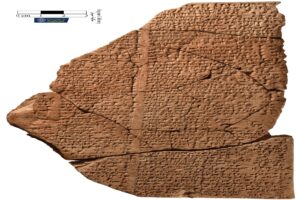While flying between the Outback towns of Marree and Coober Pedy in Southern Australia in 1998, pilot Trey Smith made a startling discovery. “I could see it from 6,000 feet,” he said about a colossal, boomerang-wielding Aboriginal man etched into the landscape. It seemed to have appeared overnight.
The small town of Marree is in the middle of Australia’s vast interior desert. Adelaide lies 700km away. Only 150 people live in Marree. Outside town, the Outback’s characteristic red soil and sparse vegetation stretch endlessly to the horizon. Yet it also boasts one of the world’s largest geoglyphs, whose origins remain baffling.
Appeared suddenly
The Marree Man is not an ancient remnant of a vanished culture, like the Nazca Lines in Peru. NASA satellite imagery reveals that the figure first appeared between May 27 and June 5, 1998. Trey Smith saw it during a charter flight on June 26.
It is 4.2km long and has a perimeter of 28km. Whoever created it carved the outline with heavy machinery like a bulldozer. The lines are up to 30cm deep and 35m wide. The end result was an Aboriginal man in a hunting pose with a stick or boomerang. The glyph also possesses a penis, scars, and a headband.
Experts say that this glyph must have been made with a GPS since it came out so perfectly. Every 10m around the outline, bamboo sticks emerge from the ground. These most likely assisted the creator as he carved the image. You need to be at a height of at least 1,000m in a small aircraft to see it fully.

Maree Man geoglyph. Photo: Peter Campbell/Wikipedia Commons
In recent years, because of erosion by wind and rain, the Marree Man’s striking outline has diminished considerably. It has faded so much that locals took it upon themselves to restore the artwork. In 2016, an intense five-day restoration took place. Also using a GPS, a team re-carved the lines and created wing grooves to trap water and encourage vegetation growth. This strategy can help prevent further erosion.
Strange faxes
Who created this huge geoglyph and why? That is the million-dollar question. Soon after the pilot discovered it, mysterious faxes started to arrive at Marree’s hotels, bars, and the local media. The first fax read: “On a plateau 36 miles northwest of Marree, there is a giant drawing of an Aboriginal more than two miles long.”
A fax to the media read: “The giant has given South Australia enormous, worldwide publicity. Now that is confirmed no laws were broken, it is our hope that your State Government can promote and make use of the tourist attraction to deliver substantial financial gains to the state, especially to local Aboriginal communities.”
Have you noticed anything…off? If you look closely, the style of writing has a rather American character to it. It uses the term “state government” and cites imperial rather than metric measurements. Was the creator American rather than Australian?
Also puzzling, some of the faxes referred to the figure as Stewart’s Giant, a reference to John McDouall Stuart, a 19th-century Australian explorer.
Theories
Several other American clues began popping up around the glyph. Someone found a plaque containing the American flag and Olympic rings nearby. Additionally, a glass jar with an aerial photo of the glyph turned up, also with the American flag and references to an apocalyptic branch of the Seventh-Day Adventists. While these clues certainly give credence to this theory, they seemed very random and pointless. Almost like a distraction.

NASA satellite images taken between late May and early June 1998. Photo: NASA
Some speculated that perhaps the Aboriginals themselves did this to pay homage to their culture. However, various aboriginal groups in the area greatly opposed the glyph, saying it disrespected ancestral lands.
Tourists started to swarm the area on foot and by air to witness this strange figure, thereby further disturbing Aboriginal land. Some declared it vandalism and said it compromised the area’s archaeological integrity.
The leading theory today involves an artist from Alice Springs named Bardius Goldberg. Goldberg had always taken an interest in Aboriginal art and culture. He also had the idea to do a work so big that it would be visible from a great height.
Rumors suggested that Goldberg had received a sum of $10,000 that could have funded the complicated project. No one knows why or from whom he received it. Documentary filmmaker Glen Adamus suggests that Goldberg got a commission to do the artwork from a businessman in Adelaide.
Goldberg has since died, but a friend of his came forward to say that the artist admitted on his deathbed that he created the Marree Man. Case closed?
Not necessarily. Some things are still amiss, and skepticism remains.
Conclusion
If he was the creator, why didn’t he come forward? Did he fear prosecution? Also, he couldn’t possibly have done it alone. He must have had help.
This in itself is strange considering that no locals or witnesses had any idea what was going on. Since heavy machinery created the glyph, it is odd that all this noisy, dusty activity just 60km outside of Marree caught no one’s attention.
While Goldberg is the most likely candidate, the question remains: How did he manage to pull it off so quickly, so discreetly, and on a large scale?






